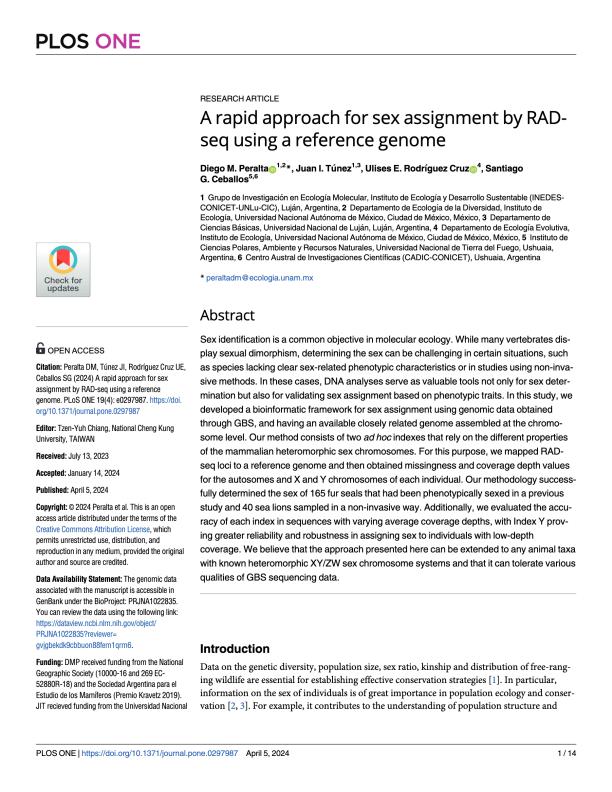Mostrar el registro sencillo del ítem
dc.contributor.author
Peralta, Diego Matias

dc.contributor.author
Tunez, Juan Ignacio

dc.contributor.author
Rodríguez Cruz, Ulises E
dc.contributor.author
Ceballos, Santiago Guillermo

dc.date.available
2024-04-29T12:35:09Z
dc.date.issued
2024-04-05
dc.identifier.citation
Peralta, Diego Matias; Tunez, Juan Ignacio; Rodríguez Cruz, Ulises E; Ceballos, Santiago Guillermo; A rapid approach for sex assignment by RAD-seq using a reference genome; Public Library of Science; Plos One; 19; 4; 5-4-2024; 1-14
dc.identifier.issn
1932-6203
dc.identifier.uri
http://hdl.handle.net/11336/234188
dc.description.abstract
Sex identification is a common objective in molecular ecology. While many vertebrates display sexual dimorphism, determining the sex can be challenging in certain situations, such as species lacking clear sex-related phenotypic characteristics or in studies using non-invasive methods. In these cases, DNA analyses serve as valuable tools not only for sex determination but also for validating sex assignment based on phenotypic traits. In this study, we developed a bioinformatic framework for sex assignment using genomic data obtained through GBS, and having an available closely related genome assembled at the chromosome level. Our method consists of two ad hoc indexes that rely on the different properties of the mammalian heteromorphic sex chromosomes. For this purpose, we mapped RAD-seq loci to a reference genome and then obtained missingness and coverage depth values for the autosomes and X and Y chromosomes of each individual. Our methodology successfully determined the sex of 165 fur seals that had been phenotypically sexed in a previous study and 40 sea lions sampled in a non-invasive way. Additionally, we evaluated the accuracy of each index in sequences with varying average coverage depths, with Index Y proving greater reliability and robustness in assigning sex to individuals with low-depth coverage. We believe that the approach presented here can be extended to any animal taxa with known heteromorphic XY/ZW sex chromosome systems and that it can tolerate various qualities of GBS sequencing data.
dc.format
application/pdf
dc.language.iso
eng
dc.publisher
Public Library of Science

dc.rights
info:eu-repo/semantics/openAccess
dc.rights.uri
https://creativecommons.org/licenses/by/2.5/ar/
dc.subject
SEX ASSIGMENT
dc.subject
RAD-SEQ
dc.subject
GENOME REFERENCE
dc.subject
SEX CHROMOSOMES
dc.subject.classification
Genética y Herencia

dc.subject.classification
Ciencias Biológicas

dc.subject.classification
CIENCIAS NATURALES Y EXACTAS

dc.title
A rapid approach for sex assignment by RAD-seq using a reference genome
dc.type
info:eu-repo/semantics/article
dc.type
info:ar-repo/semantics/artículo
dc.type
info:eu-repo/semantics/publishedVersion
dc.date.updated
2024-04-26T12:09:57Z
dc.journal.volume
19
dc.journal.number
4
dc.journal.pagination
1-14
dc.journal.pais
Estados Unidos

dc.journal.ciudad
San Francisco
dc.description.fil
Fil: Peralta, Diego Matias. Universidad Nacional de Luján. Instituto de Ecología y Desarrollo Sustentable. Consejo Nacional de Investigaciones Científicas y Técnicas. Oficina de Coordinación Administrativa Parque Centenario. Instituto de Ecología y Desarrollo Sustentable; Argentina. Universidad Nacional Autónoma de México; México
dc.description.fil
Fil: Tunez, Juan Ignacio. Universidad Nacional de Luján. Instituto de Ecología y Desarrollo Sustentable. Consejo Nacional de Investigaciones Científicas y Técnicas. Oficina de Coordinación Administrativa Parque Centenario. Instituto de Ecología y Desarrollo Sustentable; Argentina
dc.description.fil
Fil: Rodríguez Cruz, Ulises E. Universidad Nacional Autónoma de México; México
dc.description.fil
Fil: Ceballos, Santiago Guillermo. Universidad Nacional de Tierra del Fuego; Argentina. Consejo Nacional de Investigaciones Científicas y Técnicas. Centro Austral de Investigaciones Científicas; Argentina
dc.journal.title
Plos One

dc.relation.alternativeid
info:eu-repo/semantics/altIdentifier/doi/http://dx.doi.org/10.1371/journal.pone.0297987
dc.relation.alternativeid
info:eu-repo/semantics/altIdentifier/url/https://journals.plos.org/plosone/article?id=10.1371/journal.pone.0297987
Archivos asociados
